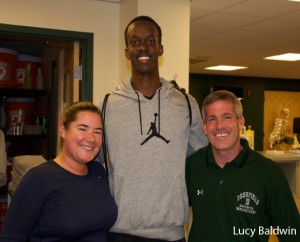As athletic trainers, Kate Bergeron and Robert Graves have never had to deal with a catastrophic case during their time at Deerfield. But should such a situation occur, both are well prepared.
 “In order to become an athletic trainer,” Ms. Bergeron said, “you must go through four years of undergraduate study at an accredited school with National Athletic Trainers Association Board of Certification (NATABOC).” She added, “You must also pass a certification exam and be licensed in most states to practice athletic training.”
“In order to become an athletic trainer,” Ms. Bergeron said, “you must go through four years of undergraduate study at an accredited school with National Athletic Trainers Association Board of Certification (NATABOC).” She added, “You must also pass a certification exam and be licensed in most states to practice athletic training.”
Ms. Bergeron emphasized that, unlike what many students may believe, the trainers aren’t here for just three hours a day and do a lot more for athletes than tape weak joints and ice sore muscles. “The trainers are here most of the day. We see a number of athletes and dancers during their free periods,” she said. “We’re also required to be out on fields whenever there are games. A trainer must be present at all football games because it has the most contact of all sports. From there, I usually head to boys soccer, then field hockey and volleyball.”
Compared to the number of injured athletes, the number of training staff is relatively small. Three athletic trainers work with dozens of student-athletes every day.
“It’s impressive to see how patient the trainers are.” said Yasmine Deswandhy ’16. “To work with so many athletes a day must be overwhelming sometimes. Yet the trainers are so understanding and work with me whenever I’m there.”
“Because we have so few trainers, it’s a matter of multi-tasking,” Mr. Graves explained. “Sometimes we could be working with two or three students together. But most athletes know what to do when they come here after one or two times.”
Surrounded by a mass of student athletes every day, the trainers treat short-term injuries as well as oversee rehabilitation for long-term injuries.
“The process that goes into treating sports-related injuries at Deerfield depends on the injury,” Ms. Bergeron said. “Many chronic injuries are treated with rest and ice to control pain and inflammation. From there, we move on to strengthening the body parts and different types of functional exercises and cross-training to slowly return athletes to their sport.”
According to Ms. Bergeron, any acute injury, such as a fracture or ligament tear would be treated similarly to a chronic injury with rest and ice at first. From there, the trainers have a protocol set in place for different body parts and go through specific exercises before allowing the athlete to return to practice.
Trainers tend to be most busy during the fall term, when many student-athletes come back from the summer after overtraining or undertraining.
“Fall’s the busiest season for the trainers because all the sports are practicing at the same time,” Mr. Graves said. “Many kids come back from the summer not properly trained to play sports again. Student-athletes may not be as ready to play in their fall sports as they are for their winter sports.”
Many Deerfield athletes have been feeling an increasing need for the trainers.
“I really appreciate the fact that the trainer’s number one concern is to make sure that I’m not injuring myself any further,” said Deswandhy. “They give me a personalized routine to make sure I’m taking the right steps to get me back into sports.”
Zahra Rawji ’15 affirmed that having access to a trainer on campus is a huge privilege: “Back at my old school, there weren’t many opportunities to talk to a physiotherapists. Having a trainer on site to check in with whenever [we need to] is very helpful during my sports seasons.”